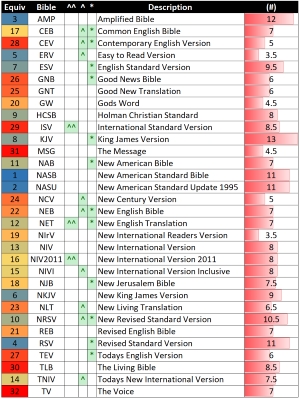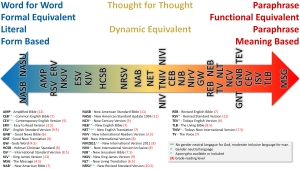
(To download the 3 bible versions charts, see the Green, Blue, & Red images below).
Thumbnail Samples of the Chart and Diagram:


https://identity-intelligence.org/content/version-bible-translation-comparison-chart.pdf
https://identity-intelligence.org/content/version-bible-translation-comparison-table-alphabetical.pdf
https://identity-intelligence.org/content/version-bible-translation-comparison-table-cold-to-hot.pdf
CHOOSING A BIBLE VERSION
There are MANY different bible translations. In my Logos bible software, I currently have 70 different versions.
How do you choose a Bible version? Which translations are most "accurate"? Which are the best? The New International Version? The King James Version? The New Living Translation?
Different bibles are translated using different philosophies and for different purposes.
BIBLE TRANSLATIONS: Literal, Dynamic Equivalent, Functional Equivalent
I use a literal translation (bibles further to the left on the diagram) when I'm trying to get a word-for-word understanding when doing Greek or Hebrew Word Studies (with today's bible software you don't need to know the original languages in order to study them). We can now do 'exegesis' without reading Greek or Hebrew, thanks to the software that will transliterate the ancient texts for us.
I use a dynamic equivalent (bibles toward the center of the diagram) when I'm trying to get a decent understanding of the original author's intent, but when I also want to pay attention to the original Greek or Hebrew.
I use a functional equivalent (bibles further to the right of the diagram) when I really want to understand the meaning of the text, and when reading the bible to my children. Grade Reading Level can also be a helpful criterion to consider when choosing a bible version (and it is included in the chart and diagram).
BIBLE VERSION CHART AND DIAGRAM
You can download these free charts and diagrams which will help you differentiate the different bible versions. These tools give you a guide to make it very easy to compare the different translations and then choose an English Bible.
TRY DIFFERENT BIBLE VERSIONS
But the best thing you can do, is choose a few of your favorite chapters of scriputre, and read them in each version you are considering! If you are going to do this I recommend you choose at least one passage from each major section:
- Torah (e.g. Genesis: so you can see how the narrative and poetry looks in each version).
- Poetry (e.g. Psalms: so you can see the difference in the poetry).
- Wisdom Literature (Proverbs or Ecclesiastes: see how the wisdom literature varies).
- Gospel Accounts (e.g. Matthew, Mark, Luke, John: some bibles don't have red letter for Jesus' words).
- History (e.g. Acts to see how the historical accounts read)
- Pauline (e.g. look at some of Paul's epistles like Romans and Colossians)
I pray that this article and these diagrams are a blessing and help to you -- and to those you love. Enjoy!
